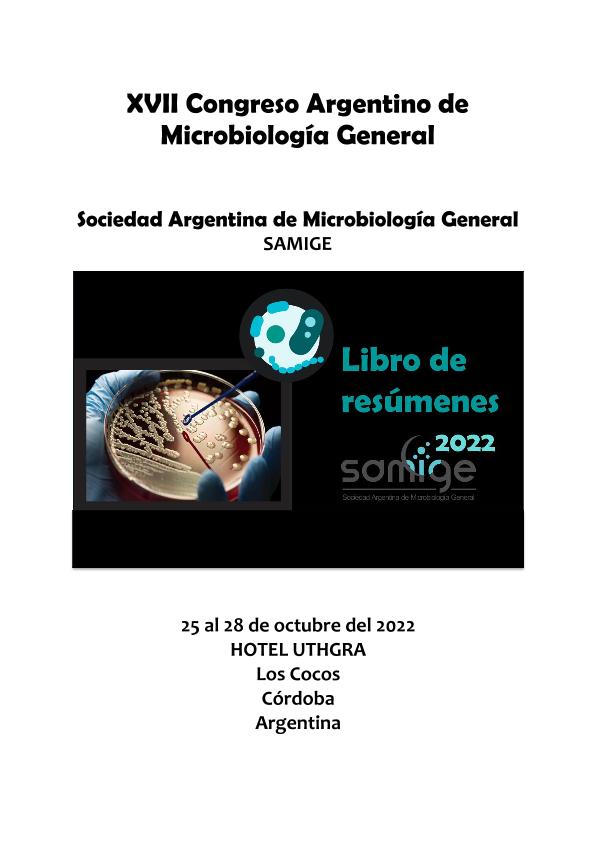Mostrar el registro sencillo del ítem
dc.contributor.author
Pérez Iglesias, Juan Manuel

dc.contributor.author
del Gobbo, Luciana Melisa

dc.contributor.author
Jorquera, Agustina
dc.contributor.author
Cortez, Agostina
dc.contributor.author
Colin, Veronica Leticia

dc.date.available
2023-09-05T19:27:25Z
dc.date.issued
2022
dc.identifier.citation
Use of Aspergillus biomass obtained from sugarcane vinasse as a cheap feed ingredient for raniculture; XVIII Congreso Argentino de Microbiología General; Los Cocos; Argentina; 2022; 150-151
dc.identifier.uri
http://hdl.handle.net/11336/210625
dc.description.abstract
Aquaculture of vertebrates faces several challenges, including the unavailability of good quality and affordable fish feeds. Therefore, this practice seeks a shift towards less expensive protein sources, such as the biomass of some species of fungi, instead of conventional sources such as fishmeal and soybeans. Vinasse is relevant worldwide due to its polluting potential; therefore, improving the management of this distillery effluent is of great importance. Hence, recycling of vinasse for the manufacture of value-added fungal biomass could reduce production costs of aquatic vertebrate’s culture feed and environmental impact of distillery effluents. Previously, our working group demonstrated that biomass of fungus Aspergillus sp. V1 produced from sugarcane vinasse present a nutritional composition within the standards recommended for use in aquafeed formulations. The goal of this study was to evaluate the use of fungus biomass as a cheap feed ingredient for aquatic vertebrate farming. For that, the creole frog tadpoles (Leptodactylus luctator) was used as a local model for raniculture. The Aspergillus biomass cultivated on sugarcane vinasse for 96 h was harvested, was lyophilized and macerated to a powder. For feed test, a chronic study (10 days) with different administrations of the lyophilized fungus (0%, 50% and 100%) compared to a commercial food (Shulet Carassius) was carried out. As variables, parameters related to tadpoles’ growth (body condition index, K) and enzymes related to oxidative stress (catalase and TBARS) were evaluated. Under the current assay conditions, feed test revealed a high survival (100%) in the fish fed with the lyophilized fungus compared to fishes feeding with commercial food (60%). Also, the statistical analyzes showed similarity between all the treatments in K index and catalase. However, the statistical analyzes revealed significant increases in the lipidic oxidation (TBARS) related to physiological stress in tadpoles where commercial food was administered (value: 38.694) compared to those fed with lyophilized fungus (value: 7.028). This study demonstrated that biomass of Aspergillus sp. V1 cultivated in vinasse is a suitable alternative an inexpensive raniculture feed ingredient.
dc.format
application/pdf
dc.language.iso
eng
dc.publisher
Sociedad Argentina de Microbiología General
dc.rights
info:eu-repo/semantics/openAccess
dc.rights.uri
https://creativecommons.org/licenses/by-nc-sa/2.5/ar/
dc.subject
ASPERGILLUS BIOMASS
dc.subject
SUGARCANE VINASSE
dc.subject
RANICULTURE
dc.subject
AQUATIC VERTEBRATE FARMING
dc.subject.classification
Otras Biotecnología del Medio Ambiente

dc.subject.classification
Biotecnología del Medio Ambiente

dc.subject.classification
INGENIERÍAS Y TECNOLOGÍAS

dc.title
Use of Aspergillus biomass obtained from sugarcane vinasse as a cheap feed ingredient for raniculture
dc.type
info:eu-repo/semantics/publishedVersion
dc.type
info:eu-repo/semantics/conferenceObject
dc.type
info:ar-repo/semantics/documento de conferencia
dc.date.updated
2023-09-04T10:47:48Z
dc.journal.pagination
150-151
dc.journal.pais
Argentina

dc.journal.ciudad
Córdoba
dc.description.fil
Fil: Pérez Iglesias, Juan Manuel. Consejo Nacional de Investigaciones Científicas y Técnicas. Centro Científico Tecnológico Conicet - San Luis. Instituto de Química de San Luis. Universidad Nacional de San Luis. Facultad de Química, Bioquímica y Farmacia. Instituto de Química de San Luis; Argentina
dc.description.fil
Fil: del Gobbo, Luciana Melisa. Consejo Nacional de Investigaciones Científicas y Técnicas. Centro Científico Tecnológico Conicet - Tucumán. Planta Piloto de Procesos Industriales Microbiológicos; Argentina
dc.description.fil
Fil: Jorquera, Agustina. Universidad Nacional de San Luis; Argentina
dc.description.fil
Fil: Cortez, Agostina. Universidad Nacional de San Luis; Argentina
dc.description.fil
Fil: Colin, Veronica Leticia. Consejo Nacional de Investigaciones Científicas y Técnicas. Centro Científico Tecnológico Conicet - Tucumán. Planta Piloto de Procesos Industriales Microbiológicos; Argentina
dc.relation.alternativeid
info:eu-repo/semantics/altIdentifier/url/https://samige.org.ar/wp-content/uploads/2022/10/Libro-de-Resumenes-SAMIGE-2022_final.pdf
dc.conicet.rol
Autor

dc.conicet.rol
Autor

dc.conicet.rol
Autor

dc.conicet.rol
Autor

dc.conicet.rol
Autor

dc.coverage
Nacional
dc.type.subtype
Congreso
dc.description.nombreEvento
XVIII Congreso Argentino de Microbiología General
dc.date.evento
2022-10-25
dc.description.ciudadEvento
Los Cocos
dc.description.paisEvento
Argentina

dc.type.publicacion
Book
dc.description.institucionOrganizadora
Sociedad Argentina de Microbiología General
dc.source.libro
Libro de Resúmenes del XVII Congreso Argentino de Microbiología General
dc.date.eventoHasta
2022-10-28
dc.type
Congreso
Archivos asociados
